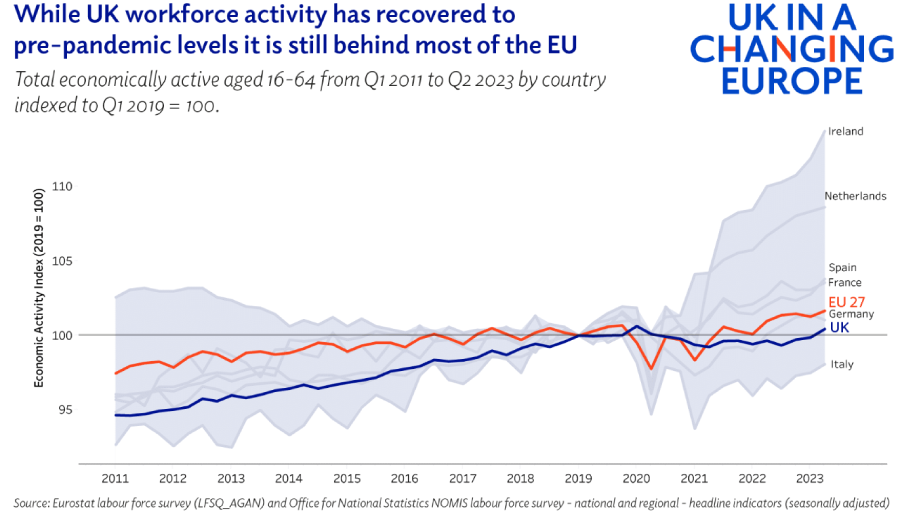
Professor Donald Houston and Stephen Hunsaker explore the UK labour shortage, suggesting that a combination of baby boomers retiring, high Covid infection rates during the pandemic, capacity constraints in the NHS, and Brexit are all at play.
This article was first published in the UK in a Changing Europe website.
Much has happened in the UK labour market since 2019, most notably the emergence of labour and skills shortages. Much of this is due to the Covid-19 pandemic, but this is not the whole story.
How does the UK’s workforce trajectory compare to other European countries?
Most European countries experienced sharp contractions in the size of their workforces in the first half of 2020 in response to Covid-19 restrictions, with subsequent labour shortages as they reopened their economies. In many countries, the number of workers recovered to pre-pandemic levels within a year or two and has continued to grow since (see chart below).

The UK is the only major European economy, alongside Italy, whose workforce remains around or below its pre-pandemic level. The UK’s workforce trajectory, however, has been somewhat smoother than Italy’s. The UK did not experience nearly as sharp a drop during lockdown. Indeed, the UK’s workforce not only contracted at a slower rate than that witnessed in Italy but also less than that in Ireland, France and Spain.
It is possible that the lack of a sharp drop in the UK could be partially explained, by the ‘furlough’ scheme in the UK to protect jobs, which kept people in the workforce. This paid 80% of wages across all sectors that could not fully operate due to Covid restrictions.
In contrast, insurance-based unemployment and disability benefits systems common across other European countries that provide income protection for a period may have enabled people to temporarily leave the workforce during lockdown but have a protected job to return to. This would explain the sharp drop and subsequent rise in European countries’ workforce activity.
Shrinkage in the size of the workforce lasted longer in the UK than in most other European countries. Furthermore, when it came, recovery was weaker. In contrast, Ireland and the Netherlands experienced strong growth in the size of their workforces following the pandemic.
Why did the UK’s workforce shrink more and recover slower?
So what lies behind this comparably poor performance? Arguably, no single explanation can fully account for why the UK’s workforce shrunk more and for longer and began recovering later and slower, than most of its European neighbours. Rather, a perfect storm of factors came to a head in the UK: the large cohort of post-war baby boomers retiring; high Covid infection rates; capacity constraints in the NHS; and Brexit.
Baby boomer retirement
An important clue lies in the fact that workforce contraction started in the UK before Covid – largely driven by workforce ageing as the tail of the large late ‘baby boomer’ cohort (including the demographic bulge induced by the children of the early baby boomers) moved into their late 50s and early 60s (ages when rates of withdrawal from the labour market due to poor health and retirement rise sharply), leaving a smaller cohort of prime working age in their wake.
This demographic effect appears to account for some of the so-called Great Retirement, which is often attributed to lifestyle reappraisal following the Covid-19 pandemic and associated lockdowns. No doubt mandated home-working during lockdowns led some people to retire sooner than they might have otherwise, but this effect was quite short-lived – as early as October 2022, the number of people aged 16-64 out of the workforce due to retirement was falling.
Health and the NHS

One other possible factor is health. The UK had higher rates of obesity going into the pandemic, making the population more vulnerable to the effects of Covid.
The rapid rise in NHS waiting lists can also not be ignored in understanding the vulnerability of the UK labour market to the Covid-19 pandemic and why workforce recovery has been slow. However, to focus solely on waiting times is only part of the story. First, a lot of people on NHS waiting lists are beyond working age. Second, a lot of people of working-age have long-term health conditions that limit the kind or amount of work that they can do but do not put them on an NHS waiting list for treatment.
The proportion of the UK working-age population who say they have a work-limiting long-term health condition rose from 16.4% to 18.1% between 2019 and 2022. Crucially, only two-in-three people aged 16-64 years with a work-limiting health condition give health or disability as their main reason for being out of the workforce, so some of the Great Retirement may have been driven by a deterioration in health rather than lifestyle reappraisal, as was often assumed by some commentators.
It is perhaps not surprising that a deterioration in population health appears to be a major factor in explaining a contraction in the size of the workforce during a pandemic of a disease from which those of prime working age (those in their 40s) are most likely to suffer long-term post-viral illness (Long COVID).
The UK also had a more resource-stretched health system than in many other European countries, meaning the impact of the pandemic on the health system’s ability to continue delivering non-emergency treatment (which can help people remain in work) may have been greater in the UK than some other European countries.
Brexit
Brexit also played a role in explaining the UK’s large shrinkage in the size of its workforce, as net migration from the EU failed to recover following the Covid-19 pandemic, coming on top of a reduction in net migration from the EU since the Brexit referendum. While non-EU migration is at an all-time high, a large portion are students and high-skilled workers who do not fill the kinds of roles that many EU migrants left behind.
Why does it matter?
Understanding the drivers of change in the size of the workforce is important to identify the sources of vulnerability and resilience to future shocks. Given the global emergence and spread of new communicable diseases (for example HIV, SARS, E. coli, Zika) in recent decades – and now Covid-19 – there may be important lessons to learn so that future health crises do not also become economic crises.
Understanding the drivers of workforce change matters for wider debates about growth and inflation – with the Bank of England paying close attention to workforce data when making decisions about interest rates – and in general, how to navigate an unpredictable global economic environment.
This blog was written by Donald Houston, Professor of Regional Economic Development, City-REDI / WMREDI, University of Birmingham, and Stephen Hunsaker, Researcher, UK in a Changing Europe.
Disclaimer:
The views expressed in this analysis post are those of the authors and not necessarily those of City-REDI / WMREDI or the University of Birmingham.
